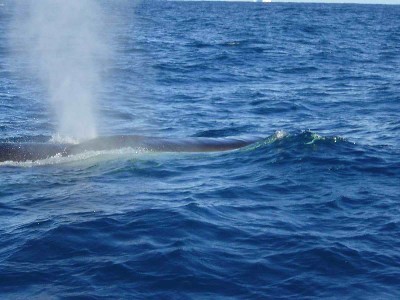Report #5: Kerguelen
Plateau oceanographic survey (Map 5).
The final portion of the Marine
Science voyage of the R.S.V. Aurora Australis constituted an oceanographic survey of the Kerguelen Plateau, including a planned deployment of 8
oceanographic moorings plus 48 CTDs. As a result, the ship would be stopping at
regular intervals during all deployment of oceanographic equipment. During these stations, the whale survey would
be reduced to incidental observations from the bridge. As the CTD is lowered to the seabed, which in
many cases exceeded 4600 m in depth, these stationary periods regularly
continued for over 4 hours. The short
distances between CTD and mooring sites led to only short whale surveys on full
effort (Map 5). Confounding this complex
survey layout was the inclement weather that reduced search effort for 11 of
the total 17.5 days.

Map 5. Whale
sightings in the Kerguelen Plateau.
The total of 94 whale sightings,
of a minimum 333 animals (Table 5), is therefore surprisingly high considering
the reduced search effort in the region.
Due to the inclusion of a large group of 120 long-finned pilot whales in
this total, a breakdown of the whales seen into three categories allows greater
understanding of the data. Odontocete sightings were only of the family Delphinidae, including 2 groups of killer whales, the large
group of pilot whales and the first sightings of hourglass dolphins for this
voyage. The gregarious nature of this
family led to a total count of 154 individuals in only 5 sightings. Conversely, almost the same number of
individuals (159) was seen in 74 sightings of mysticetes. Fin whales were again the most commonly seen
species, and a large proportion of the unidentified whales probably included
this species. The large number of
unidentified animals (15 sightings of 20 animals – Table 5) can be attributed
to high swells which reduced the effectiveness of the big-eye binoculars for
species identification. Unfortunately,
this unstable sea was encountered in the region of apparently highest cetacean
abundance off the north-eastern drop-off of the BANZARE Bank (Map 5).
Table
5: Kerguelen
Plateau whale sightings.
|
Species |
Sightings/animals
on the Kerguelen Plateau survey |
|
like fin whale |
|
|
unidentified small whale |
- |
|
unidentified baleen whale |
1:1 |
|
undetermined minke whale |
5:7 |
|
long-finned pilot whale |
1:120 |
|
like minke whale |
- |
|
killer whale |
|
|
humpback whale |
|
|
like humpback whale |
3:4 |
|
sperm whale |
- |
|
Antarctic minke whale |
|
|
unidentified cetacean |
- |
|
unidentified whale |
|
|
unidentified large baleen whale |
6:9 |
|
fin whale |
|
|
unidentified large whale |
4:6 |
|
sei
whale |
- |
|
unidentified small baleen whale |
- |
|
like sperm |
- |
|
like southern bottlenose whale |
- |
|
like killer whale |
- |
|
like sei whale |
- |
|
small baleen whale |
- |
|
hourglass dolphin |
|

Fin whale blowing
Of the odontocetes seen, the two sightings of hourglass dolphins
occurred within half an hour of each other on the BANZARE Bank. The long-finned
pilot whales occurred in water deeper than 3000 m (Map 5), a similar depth
within which the previous three sightings of this species occurred (Map
1). Both groups of killer whales seen
were in the shallower waters of the continental shelf.

Hourglass dolphin
Identified baleen species
included fin, humpback and minke whales, all three of which were seen
throughout the region surveyed (Map 5). Both fin and humpback whales were seen
feeding on the Kerguelen Plateau. Most humpback whales seen consisted of pairs
swimming together, although a single animal swam up to the ship past the CTD
door while at a CTD site. Similarly, the single sighting of a minke whale
occurred when it swam around the CTD wire several times during an oceanographic
site.
The route from Mawson to